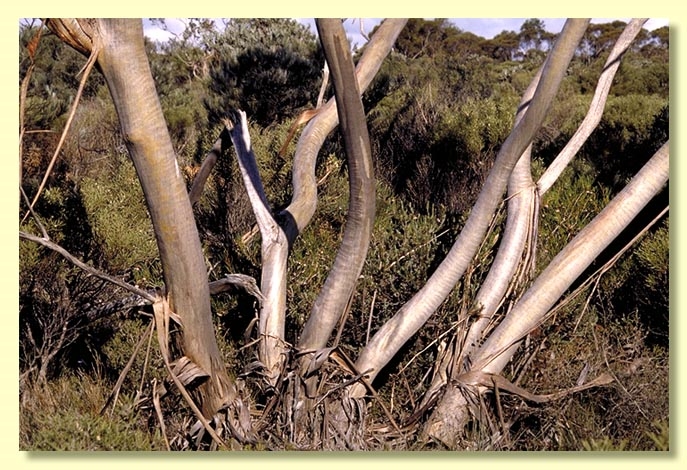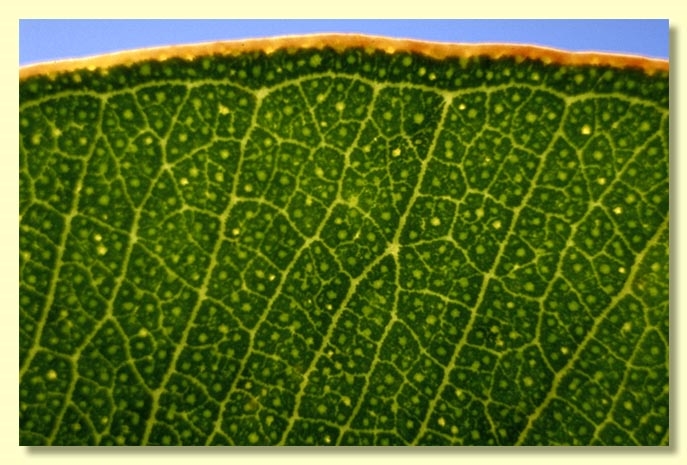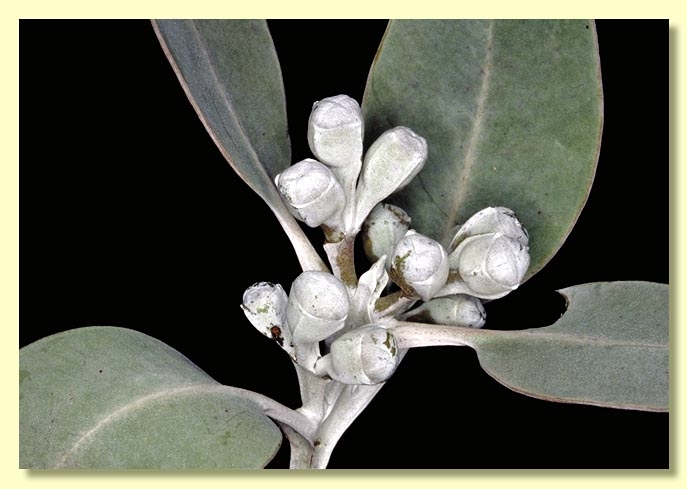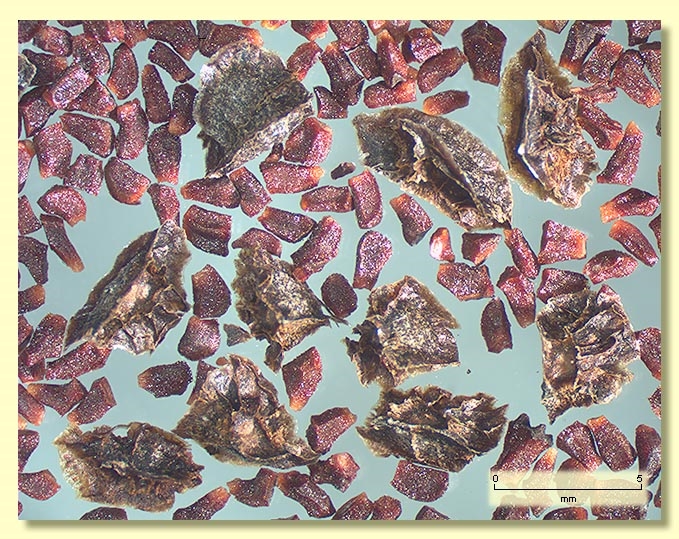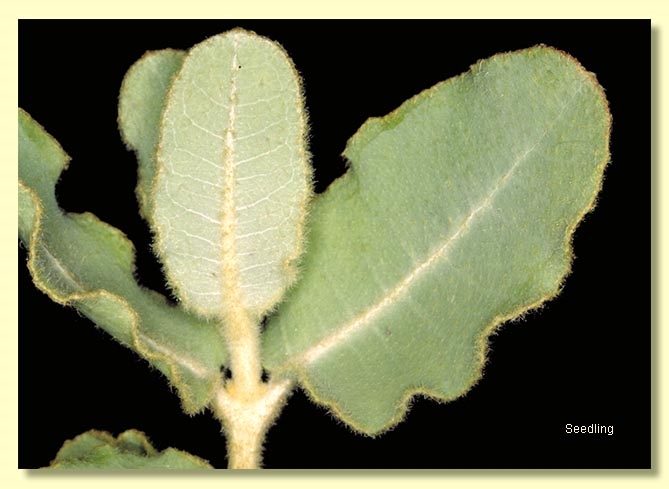Euclid - Online edition
Eucalyptus pleurocarpa
Eucalyptus | Eudesmia | Limbatae | Heteropterae | Tetraedrae
T: Western Australia: Cape Riche, Nov. 1840, L.Preiss 253; n.v.
[Misapplied name; Eucalyptus tetragona (R. Br.) F. Muell., Fragm. 4: 51 (1864), auct. mult. The type specimen of E. tetragona is intermediate in character between E. pleurocarpa and E. extrica Nicolle].
Bark smooth throughout, grey to grey-brown.
Branchlets glaucous; oil glands present in the pith.
Juvenile growth (coppice or field seedlings to 50 cm): stems square in cross-section and prominently winged, glaucous, sometimes hairy on the lower stems, leaves petiolate, opposite, ovate to oblong to elliptical to cordate, glaucous to grey-green, 10–12 cm long, 6–6.5 cm wide, apex acute to rounded, base lobed to truncate to rounded, lamina sometimes hairy on the lower leaves, margins entire sometimes irregularly toothed on lower leaves due to hairs.
Adult leaves opposite to sub-opposite, petioles 0.8–2 cm long; blade broadly lanceolate to ovate to elliptical, 4.5–14 cm long, 2.5–7 cm wide, base rounded to tapering to petiole, concolorous, dull, grey-green to glaucous, side-veins greater than 45° to midrib, reticulation sparse to moderate, intramarginal vein present, oil glands mostly island.
Inflorescence axillary single, peduncles broadly flattened, (0.5)0.6–1.8(2) cm long, buds 3, pedicellate (pedicels 0.2–0.8 cm long). Mature buds obovoid (0.8–1.3 cm long, 0.5–0.9 cm wide), hypanthium four-angled, glaucous, outer perianth whorl sepaline, inner whorl operculate, operculum rounded, stamens grouped in four clusters, inflexed, anthers oblong, versatile, dorsifixed, dehiscing by longitudinal slits (non-confluent), style short or long, stigma tapered, locules usually 3 or 4, the ovules arranged in 4 distinct vertical rows on the placentae. Flowers whitish.
Fruit pedicellate (pedicels 0.2–1.2 cm long), barrel-shaped, rarely cylindrical, 1.2–2.2 cm long, 1.4–2(2.1) cm wide, usually four-angled, glaucous, disc descending, valves 3 or 4 enclosed or near the rim.
Seeds dull brown to black or greyish, irregularly pyramidal in shape or somewhat flattened, with a ragged flange around the edge, 5–6 mm long, sides ribbed, surface smooth not deeply pitted, hilum ventral/terminal.
Cultivated seedlings (measured at node 10): cotyledons orbicular; stems square in cross-section, glaucous and hairy, leaves petiolate, opposite, ovate to oblong to cordate, 6–7.5cm long, 3–4.5 cm wide, glaucous, margins entire or irregularly toothed, apex rounded, base lobed to truncate, lamina hairy.
Flowering has been recorded in January, February, April, October, November and December.
A straggly mallee occurring disjunctly north of Perth in the sandplain to about Eneabba and more extensively to the south-east from Pingaring to east of Esperance. The stems are smooth and strongly glaucous when young, and the crown consists of juvenile leaves only which are large and sessile.
E. pleurocarpa (published in 1844) was until recently included in E. tetragona (published in 1864). Eucalyptus tetrogona is type species for the subgenus Eudesmia, but the type specimen is intermediate in character between Western Tallerack (E. pleurocarpa) and eastern Tallerack (E. extrica, published in 2000) which has green, opposite leaves and no glaucous parts. Consequently the name E. pleurocarpa being published earlier and representing a widespread and recognizable entity should apply to Tallerack, and the well-known name E. tetragona regrettably should no longer be used.
Eucalyptus pleurocarpa belongs in Eucalyptus subgenus Eudesmia section Limbatae because of the combination of cotyledons reniform in shape and folded and clasping in embryo, and buds with the calyx free and evident as four small teeth around the midline of the bud. (Sections Ebbanoenses and Reticulatae in this subgenus have the calyx fused to the corolla and evident as four small teeth at the apex of the bud.) Within subgenus Eudesmia section Limbatae, E. pleurocarpa belongs in the series Heteropterae subseries Tetraedrae, that is further characterised by having seedling leaves with stellate hairs, the presence of oil glands in the pith of the branchlets, stamens arranged in four bundles, flanged more or less pyramidal seeds and buds and fruit square in cross-section. The other species in subseries Tetraedrae are E. gittinsii, E. conveniens, E. extrica, E. eudesmioides, E. erythrocorys and E. roycei. It can be distinguished from E. gittinsii and E. extrica by having glaucous branchlets, leaves and buds (E. gittinsii and E. extrica never glaucous). E. eudesmioides differs by having smaller leaves, buds and fruit. E. erythrocorys is easily separated by its bright red buds and yellow flowers, and E. roycei has its buds in groups of seven in each umbel (in groups of three for E. pleurocarpa). E. conveniens is morphologically intermediate between E. pleurocarpa and E. gittinsii. E. pleurocarpa differs by having glaucous branchlets and wider, ovate to elliptical to broadly lanceolate, shortly petiolate, glaucous leaves.
Intergrades between E. extrica and E. pleurocarpa are common in the coastal area immediately both east and west of Esperance. The well-known name E. tetragona is based on such a specimen and regrettably can no longer be used, being replaced by E. pleurocarpa.




